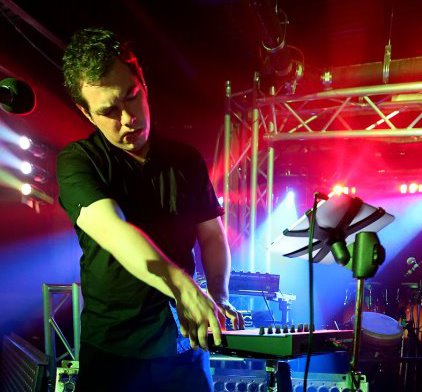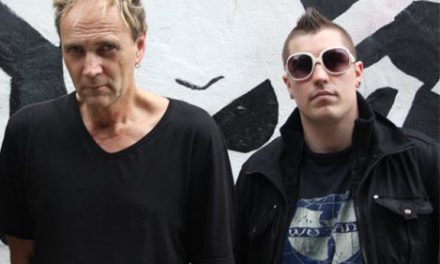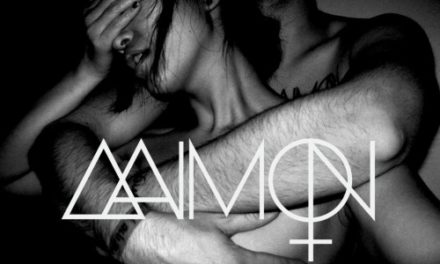“…the vocabulary of electronic music has become incredibly deep, with all sorts of history. I find it hard for the lines NOT to blur.”
If you aren’t yet familiar with Réal Cardinal’s work as Comaduster, you soon will be. Heads in the know have been singing the praises of the young Canadian producer and sound designer since before his debut 2009 debut EP Slip Through dropped, and anticipation for his first full-length LP has been bolstered by high-profile remixes for names like Aesthetic Perfection, Architect and iVardensphere, not to mention his appearance at Mutek (Canada’s most prestigious electronic music festival) a few years back. With his capacity for pressing industrial, IDM, bass and host of other sounds into the service of his songs, Cardinal is in the enviable position of appealing to music fans across genre borders and boundaries. On the eve of the release of Hollow Worlds Réal took some time to answer our questions regarding the producer/songwriter divide, working in an all-digital environment, and how the album’s lengthy gestation affected its final form.
ID:UD: One of the most striking things about the new LP is the convergence of technique and songwriting. The production and programming is very deep and complex, but always in service of the songs, which seem very personal and emotional. Is there a creative tension between those two aspects of your writing? Do you ever find yourself favouring one side of the equation over the other during recording?
Réal Cardinal: There is definitely a battle going on, and I very actively try to balance both aspects. As a sound designer, I’m very interested in texture and sonic identity, and I like to try and explore all aspects of sound as much as I can. A lot of the time I get stuck in wormholes, only to come out on the other side and realize that I’ve clouded the true ideas of the song. But that process in and of itself kind of helps me ‘reveal’ what’s important in the music sometimes. Sometimes the true idea of the song emerges from a very specific sonic idea. A good example of that on this record would be the song “The Send Off”. The whole inspiration of the ‘song’ aspect of that tune exploded from the echoing drone sound that it starts with.
I tend to put on different hats with a bit of time in between to make sense of it all. I guess that kind of simulates the ‘band’ or ‘writer/producer’ or even an ‘artist/remixer’ relationship; it just takes more time! Lots of building, tearing down, and rebuilding. Some of the tunes on this record were built up and taken down multiple times, usually quite painfully!
ID:UD: How has working in sound design professionally affected the development of your own work? Is it easy to port over lessons or skills learned through your day job, or do you try to keep those separate in order to maintain a distinction between paying the bills and your own creative work?
RC: Being a professional game sound effect designer has definitely helped bring out my detail oriented approach to audio, for better or worse. I’ve definitely been able to apply the technical aspects I’ve learned about tonal balance, noise control/contour, ear fatigue, dynamic impact, psycho-acoustic ideas to how I design sounds in my music, and I learned a lot about low end and impact design when working on the Mass Effect franchise.
In electronic music, sound design is as much of a part of composition as melody or harmony is for me. I think it’s amazing to have the freedom to play one note, the sonarity of which can evolve and imply whole chords, or physical spaces, texture, rhythm, or a combination of all. It adds a lot of information to what is commonly thought of as musicality.
But, I do need to create separation in my mind when it comes to process. It took me a long time to learn how to be creative at home after working on sound design (usually electronic) at the office all day. Initially I had to go so far as using very different toolsets and approaches at home, even if what I was creating was fundamentaly similar to my day work. The overlap is something I think a lot of sound designer/musician combos struggle with.
ID:UD: Hollow Worlds is pretty catholic insofar as the influences you’ve integrated into the record’s DNA, we hear some dubstep, bass music and IDM touches, along with some technoid and even symphonic and soundtrack touchstones at various points. Is that cross breeding of genres something you approach consciously, or is it something that just comes about naturally as part of your process of writing and producing?
RC: Industrial and IDM have been in my blood from a young age, so I think some of those aspects will probably always be somewhat inherent in my tunes. I’ve always been inspired by artists who can mold genre to their creative will, to the point where it becomes auxiliary. Meta-musicians, or something! Daniel Myer has always been a huge influence in and around the industrial scene for me. In recent years, artists like Jon Hopkins, Trifonic, Apparat, Trentemoller and Max Cooper have been artists who pull this off for me. The whole tonal direction behind this record started for me with the title track. I made that song first.
I was definitely inspired by some of the more visceral sonic elements going on in a lot of the bass music from the UK and Europe, and at the same time I was on a huge ambient and post-rock kick. It kind of occurred to me that I had never really heard any music that had the aggressiveness of some of the harder dubstep and industrial sonics juxtaposed with soaring post-rock guitar textures. That song was kind of my first experiment with this. I knew I wanted to condense the converging ideas in song structure…and that began the process about 3 1/2 years ago. I really wanted to take what I could from my influences, digest that as much as I could, and then try and present all of these elements in a new context. I really think the vocabulary of electronic music has become incredibly deep, with all sorts of history. I find it hard for the lines NOT to blur. I’m conscious of the genre bending, but I try take aspects that I think are effective with the narrative of the songs. It’s hard not to sound like a post-genre douche! *laughs*
ID:UD: Your songs are intricate, to the point where a lot of details and micro-variations only become apparent upon multiple listens. We’re curious as to how that comes about, do you follow a traditional demo to finished song model, adding details along the way or is it less cut and dried than that? How do you know when it’s time to stop adding to a song?
RC: It varies a lot, but there is almost always a build, tear down, and rebuild process, and the idea as to what the details become is never very clear from the start. I think a lot of the micro-complexity comes from almost ‘remixing’ my own stuff. A lot of the time I’ll have a synth-line or a drum part in a song for a while, and then one day I’ll bounce it down, wash it in reverb and delay, and just cut up the audio, the way I would in a wacky remix. Then THAT becomes the new ‘synth’ line / pad. I like it when I can hear elements that have been (or appear to be) re-contextualized or re-appropriated in music. It can give the sound a sense of instability that I’m drawn to.
I like when I hear chaotic thinking put to meticulous order. I can appreciate that struggle. In the late stages of a project I’ll look at a layer of something and not have a single clue how I actually made it. This process makes it interesting when people ask me for individual elements of my songs to remix. “Can I have the MIDI for this pad/synth line?” It almost always ends up as audio soup in the end.
“My music lives and dies in the DAW…I embrace it as a tool.”
ID:UD: We’ve discussed this a few times previously, but as an artist who is firmly set in the DAW world, we’re curious how that affects the creative process for you. Do your songs start in the workstation, or do you start composing externally and then import it into that world? Do you find the specifics of your software affect how you approach songwriting, and do you ever want to break out of that?
RC: I’m definitely more productive when I have a small, but concentrated setup. It might not feel as glamorous or fun when I’m making music, but I’ve learned to kind of get over that and try to look at the whole work, and have my fun in different ways. I’ve had some pretty ridiculous set ups over the years. My music lives and dies in the DAW, Ableton Live being my choice. I embrace it as a tool. I simply couldn’t do what I do without spending most of my time there. Ableton in particular has a lot of technical and creative sides that I just couldn’t do in other software quickly. I tend to use very large and complicated effect and processing chains, but Ableton lets me keep them all on one channel with parallel processing, etc. Then I can just drag that track/group of tracks/preset/song to my personal library and save it for easy recall later. When my ideas hit, they hit hard, and I need sharp and focused tools to get the detail I like quickly.
For breaking out a bit, I have FLstudio and Reason. I mainly use those for additional ideas or approaches when I’m a little ways into a production. I feel that tools can affect process, but I personally look for the ones that are the most transparent to my own ideas. Aside from reason, they usually they don’t adhere to the traditional studio set up model for me. None of my own music (or even a lot the music I really like) was ever made in those situations, so I don’t feel the need to emulate it.
ID:UD: On a related note, it seems that although there’s a prevailing move towards analogue and modulars amongst a lot of synthesizer enthusiasts. You seem to be going in the opposite direction, working in a purely digital world. Is that a reactive choice?
RC: It’s not reactive, it’s more based on personal experience. I have my massive ups and downs with analogue gear, and I’ve had various modular rigs and pieces of analogue gear in the past. There are things that I really like about it like the high audio bandwidth, chaotic approaches to sound design, the immediacy, and the fact that you can push the audio really far before it just collapses in to non-descript noise (the bad kind!), or make some really badassed noise! So for very raw material, I dig the analog world.
That’s about it for me, though. I really dislike composing with analog gear. I feel like I have to spend more time figuring out how I’m going to get my idea out of the gear than it should, and I usually get frustrated because it’s never quite ‘right’, despite it sounding interesting. It always feels like I don’t have enough conceptual resolution, and that I always just kind of have to settle and process the hell out of stuff anway. I can understand the appeal of stumbling across sounds that way, but only a very little of my own process relies on that kind of experimentation. I think that’s kind of one of the blackholes of the analog modular world. It’s so fun and immediate to get going, but very, very difficult to focus complete ideas to a degree of quality. And then if you just had that one module, you could add one more piece to the compositional puzzle…You see where this goes? I totally get it! It’s a nutty thing to play around in that world. Guys like Richard Devine have that down. He’s incredibly virtuosic and can make SUPER compelling work on just a modular. But it only takes a quick search of ‘analog modular synth jam’ on Youtube to see how difficult it really is to compose on these!
I still do have hundreds of hours (no, really!) of modular and synth jams recorded at really high sample rates, and I use those sounds from time to time if they work. I can get close enough to what I like out of analog gear with U-he synth plugins and FXpansion DCAM.
ID:UD: So how do you integrate that approach into performing live as Comaduster? When we say you last time there was definitely an emphasis on the performance aspect (ie electronic percussion, singing, live guitars): how do you maintain the very precise nature of your music and workflow while introducing the random elements that come with live performance?
RC: That’s a good question. For a very long time, I didn’t intend on playing this stuff live. Slip Through was mainly a collection of songs that I had laying around for years. When I was finishing that record I kind of tossed out the idea of ever playing it live, added tons of impossible layers, and mainly focused on the listening experience of the record. I had been playing lots of one off ambient sets where I would basically write a new piece each time I played and just kind of jam it out. In the summer of 2011 I got to play one of my audio visual works at the MUTEK Montreal festival, and that really got me hooked on playing live again.
In the winter that year I sat down with my friend and live bandmate David Murphy and talked about the possibility of playing the songs live. Dave is awesome, I wouldn’t have been able to do this without his help. Production on Hollow Worlds had already started, and the songs seemed to be a bit easier to approach from a live angle. We basically figured out that we should let the computers do what they’re good at, and handle all of the precise stuff like really precise live glitching, FX changes, Automation, etc., so that we can focus on what’s important to play at the time, and hopefully what’s interesting to watch, rather than be stuck behind a wall of gear or something. Everything is done off of one laptop which is run at a really low latency. The vocal mic goes in there and is processed through it. The guitars all run through guitar rig. My controller is programmed to do various things throughout our sets; at certain parts I’ll be playing synths, at other times it will be cut up stems of the tunes, and at other times it will be for live vocal effects. I have an electronic drum pad in front of me to play parts out at times. We try to add new spins to some of the songs live to make them more relevant in a live context. A good example of this is the stuff we are doing for “Winter Eyes” live. Dave’s guitar is getting hacked to peices to follow the crazy FM glitchy synths in that tune. The whole experience has been really rewarding for both of us.
ID:UD: Your vocals are at the center of a lot of the songs on Hollow Worlds, and you sound a lot more assured in that regard than in the past. What’s changed? How important is singing on your own material to you as a means of conveying certain personal aspects of the songs?
RC: I’ve been singing for quite a while, but vocals have always been the hardest thing for me. Everything about it. The performance, the lyrics, the recording, the editing, the mixing…and then all of the ‘trouble’ the vocals can cause. “Man, this vocal is finally sounding good, but that really cool synth line is buried now… guess I have to ditch it”. The electronic geek in me cringes when I have to do vocal work. It’s taken me a long time to figure out what I like about my voice and what I don’t. I never really got it quite right before. I kind of had a better idea this time around from the start, but it took a while to refine, especially considering how complex some of the tunes are. I really thought a lot about my vocal range, and texture, and practiced a lot. I ended up trying a LOT of different vocal recording set ups in various places before I really got it down. I ended up settling on something ridiculously simple, because in the end it really does come down to the performance recorded, and how comfortable you are when you’re doing it.
“‘Dark, hopefully approachable electronic music’ is where I set the dial for this project.”
ID:UD: The album’s had a very long gestation period, with you having begun work on it well before the agreement to release it on Tympanik came about. Has that been frustrating, or were you happy to have time to work on the tracks in close detail?
RC: It was definitely a frustrating process, but I really feel it took just as long as it needed to, with a nice kick at the end. It was extremely rewarding to finish. Paul at Tympanik was in my corner early on, and was very understanding that this was going to take a bit of time. I’m really happy that this record could come out on Tympanik, as the idea of the label really goes hand in hand with what I try to achieve with Comaduster.
I’m really proud of this record, despite there being times when it was completely not aligned with what I was listening to, or even interested in musically. I really made sure to stick to my guns with the core ideas, sometimes not identify with them at all, sometimes let them change a bit, but be confident that I laid down something with emotional potency. I think a lot of good comes from that struggle in the end. It’s really hard for someone like me to stick to ideas like the ones conveyed on this record for a long period of time. Especially while working full time (sometimes a lot more than full time) doing really detailed sound work. It’s so easy to just follow something shiny and do something different, as that first rush of feeling the expanse of ideas as it opens in front of you can be super addictive. The next Comaduster incarnation will be different when it comes to influence. I think that’s something that people can always expect from this project, but I’ll always try to maintain a sonic identity. ‘Dark, hopefully approachable electronic music’ is where I set the dial for this project.
Hollow Worlds will be available digitally and on CD via Tympanik Audio on June 18th.





![An Interview With [:SITD:]](https://www.idieyoudie.com/home/wp-content/uploads/2011/10/sitd-440x264.jpg)


So stoked for this record — great article, ID:YD.
Thanks Darryl!
been a huge fan since the Daedal days, really looking forward to this!